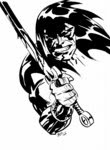Screengrab - "T'aint no guns allowed at t'dinner table!"

"Matewan" is a masterpiece. John Sayles' best film, and one of the greatest and most overlooked films of the 1980s, it tells the story of a Miners Strike in West Virginia in 1920 which eventually ends in horrible violence.
Sayles is a fascinating director. A true independent, with a maverick streak, he writes, directs and edits each of his own films, writes novels and short stories, acts in other films as well as working as an uncredited script doctor on bigger movies for the studios, notably "Apollo 13". He was in the middle of a rich seam of creativity in the late 80s, when he made "Matewan". His next film, "Eight Men Out"(1988) was set in the same historical period as "Matewan", but in the utterly different world of East Coast Baseball. The two films do have some thematic similarities, with their stories of groups of comrades facing coercion, moral courage and the damage wrought by politics.
Sayles has always been a great writer. Each of his films, from his first, "Return of the Seacausus Seven" (1980), is beautifully written, with wise, truthful, rounded characters, nice, frequently witty dialogue and unforced, organic plotting. His visual style has been more of an issue with critics. He can be slightly pedestrian visually, though his storytelling is always clear and his editing is natural and smooth. His solution to his visual limitations seems to have been to hire the best Directors of Photography he possibly could.
"Matewan" had a budget of just $4 Million, which is a tiny amount for such an ambitious film which is so dependent on a convincing, detailed period recreation for its authenticity. Sayles wisely recruited the great Haskell Wexler as his cinematographer, and as a result, "Matewan" is hauntingly beautiful, full of muted, dusky lighting and striking compositions.

Its plot details the arrival in the town of Matewan of a young, idealistic union Organiser, written by Sayles and played by Chris Cooper as an almost mythic figure. His attempts to unite the striking miners and the immigrant scabs brought in by the Mining company result in an escalation of hostilities by the company's thuggish strike-breakers. Alongside Cooper, there are appearances by actors who would become Sayles' semi-regulars like David Strathairn and Mary McDonnell. There is also a striking performance from Will Oldham as a young miner-cum-preacher. When I first encountered Oldham in his guise as a musician, some years after I had seen the film, I was shocked to discover that the man responsible for this music was the actor from "Matewan". He's as startling a screen presence as he is a songwriter, and indeed all of the films performances are strong. Sayles has always been a fine director of actors. But perhaps his most obvious gift is a talent for Altmanesque multi-character narratives, such as "City of Hope" (1991), "Lone Star" (1996) and "Sunshine State" (2002). "Matewan" flirts with this sub-genre, following the effects of the strike and Cooper's arrival upon many of the people involved. Sayles' work generally has a significant political component also, and "Matewan" is perhaps his most explicitly political film, with its portrayal of a labour dispute as a Manichean struggle between good and evil, informed by the cynicism the distance of 60 years of labour struggle in America has provided him.
That struggle finally erupts in the film's climax, inspired by the historical "Massacre of Matewan", when the Union thugs and the miners battle in the town. Sayles' screenwriting for the studios has tended to take in more genre material than his own directorial career (he made his name as writer on films like "Piranha" (1978), "Alligator" (1980) and "The Howling" (1981)), but "Matewan"s finale seems to suggest a classic Western scenario, with the two sides meeting on a railway line before an apocalyptic gunfight begins. The shooting of this sequence itself evokes Sam Peckinpah or Walter Hill, with heads exploding like ripe fruit and the air ringing with the reports of fired weaponry. Its a fantastic, ferocious climax, unlike anything else in Sayles' career, and all the more powerful and surprising for that. It also shows him - in collaboration with Wexler - as a visually exciting director, in perhaps the only straight set-piece he has ever attempted in his career. But he shows us the consequences of such violence - characters lie dead and bleeding. Others weep over the bodies of their loved ones, and Sayles' camera takes it all in, just as it had the carnage beforehand. Its a great ending to a great film in what remains an interesting, unique career.
Labels: film



0 Comments:
Post a Comment
<< Home